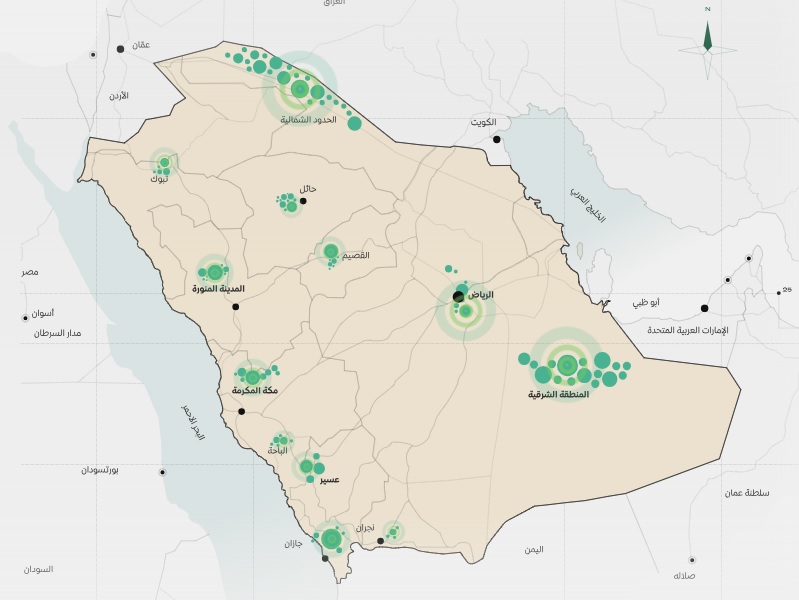
Gray water treatment and afforestation in the Kingdom of Saudi Arabia
The relationship between gray water treatment and afforestation is strong, as gray water treatment is the ideal solution to the challenges our world currently faces, which extend from environmental degradation to energy, food, and water shortages for the world’s ever-growing population. The cause of these problems is primarily man-made. Humans depend on resources, but most of our natural resources are finite and non-renewable. Many resources, such as minerals, evolve very slowly over hundreds of millions of years. If resources are not used sustainably they will be exhausted, leaving future generations barren and empty-handed. Nowadays, humans inappropriately manage their resources by achieving short-term benefits while causing pollution and degradation to the environment.
By taking advantage of the appropriate knowledge and technology currently available to us, we can solve many of the problems that the world faces today through the proper use and optimization of the potential of available resources in a sustainable manner. The following describes the use of available resources that have not yet been effectively used for planting forests in arid regions. Afforestation is the planting of trees on land that was previously used for purposes other than forestry.
Exploitation of gray water treatment and afforestation in arid areas
Drylands cover an area equivalent to one-third of the Earth’s land area, where more than one-third of the world’s population lives. According to the Food and Agriculture Organization (1989), arid regions include hyperarid, arid, and semi-arid areas accounting for 4.2%, 14.6% and 12.2% of the world’s total land area, respectively. The two largest subtropical deserts are the Sahara (9.1 million km²) in North Africa and the Arabian Desert (2.3 million km²) on the Arabian Peninsula.
Fresh water makes up only about 2.5% of global water resources and 97.5% is salt water (UNEP, 2008). The usable proportion of freshwater sources represents less than 1% of the total freshwater, i.e. only 0.01% of the total water on Earth (UNEP, 2008). Water shortages in many arid regions pose a serious obstacle to human well-being and economic development. However, wherever people live, wastewater is generated from municipal, industrial, and agricultural activities.
Unused wastewater poses serious risks to human health and the environment, as well as a waste of valuable water resources. Municipal wastewater or sewage can be partially treated and then used to provide water for irrigating trees.
Wastewater is high in the essential plant nutrients nitrogen and phosphorus, which are also essential for tree growth. Furthermore, the sludge or solid waste remaining after wastewater treatment can be used to produce renewable energy (e.g. biogas) and soil amendments.
In short, the potential of available resources (unexploited desert land, sunlight, wastewater, and nutrients contained in wastewater) is efficiently used to create agroforests in arid regions, thus producing renewable resources (such as wood, woody biomass, or biofuel). In addition, the solid waste potential of wastewater is also used to produce renewable energy and fertilizers.
Benefits of afforestation in arid areas
Afforestation has many purposes depending on the facility’s objectives, whether to produce timber, biomass, or biofuel crops, to sequester carbon or for environmental stimulation. Afforestation in arid areas has a multi-functional approach where newly established plantations can have significant economic, environmental, and social benefits such as the following:
- Reducing pollution as tree growth absorbs carbon dioxide from the atmosphere.
- Protection from desertification, stabilization of dunes, prevention of erosion, and protection of coasts.
- Efficient use of scarce water resources.
- Wood production and biofuel crop production, as a source of renewable energy.
- Protecting human settlements from wind and sand.
- Food security for a growing population by protecting new arable and reclaimed lands from winds and combating desertification.
- If cultivated areas (e.g., dedicated to food production) are protected by forests (greenbelt/windbreak). There will be a significant reduction in environmental pressures (reduced plant damage by frost, sand deposits and insects, improved irrigation and fertilization efficiency, conservation of moisture in plants and soil) and improved the local climate. Thus achieving higher productivity of protected crops.
- Creating new job and qualification opportunities. Create new forest-based and allied industries, which will help enhance employment opportunities and national economic development.
- Providing recreational opportunities for residents and tourists due to the attractiveness of forests in arid areas.
Advantages of using gray water treatment in afforestation
Here are the advantages of gray water treatment:
Reduce water use
With the use of a gray water recycling system, the amount of water previously used can be cut in half. It is known that water is an essential asset for us. It is a resource that must be preserved for future generations and in order to do this, gray water recycling is the best option.
Budget saving
If you are hit with high bills regarding water usage. By incorporating a gray water recycling system, your water bill will be cut in half.
Heat recovery
Hot water contains thermal energy, which decreases every time we use bath water, wash water, or hot water for various other things. The gray water recycling system uses thermal energy to warm new cold water. This means that its use reduces the amount of energy used by up to 60%.
The reduced water is sent to wastewater facilities
Depending on where you stay, wastewater can be avoided from entering canals without treatment using a greywater recycling system. Some urban communities work hard to meet the requirements of their sewer system. As a result, untreated wastewater settles in places where no one needs it.
More conscious use of water
The changes and developments you make through the use of a gray water system can have a huge advantage for both you and nature.
Reclaiming nutritional supplements
Recycled gray water contains supplements that are supposed to be beneficial for your plants’ growth. So, use recycled gray water to water these plants.

























